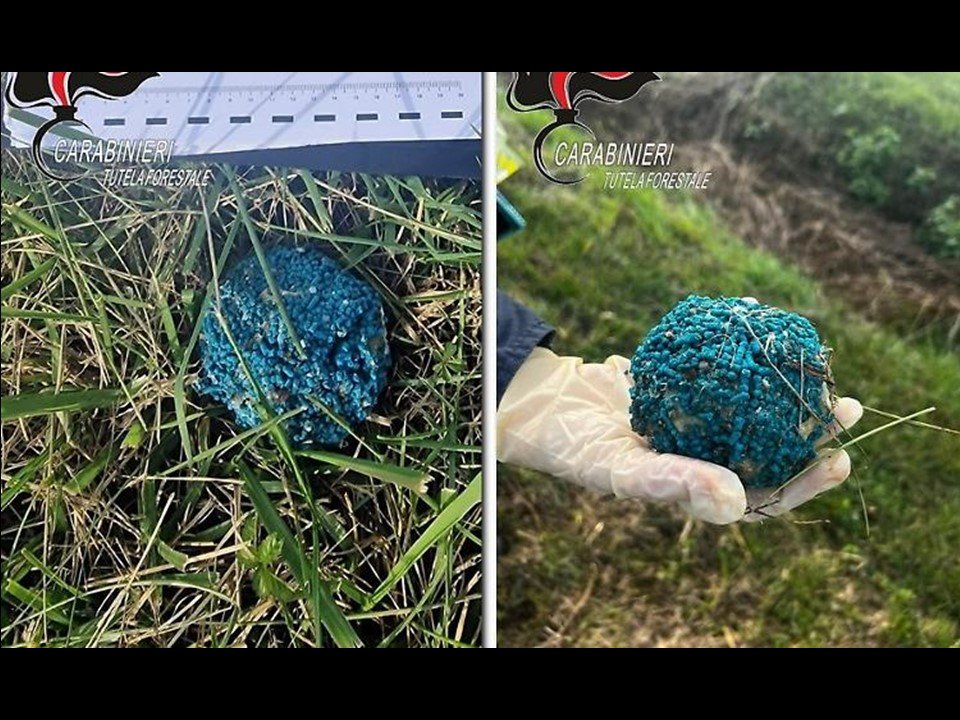What are poisoned baits?
The use of poisoned baits is one of the most serious threats to the conservation of the wolf and is a dangerous practice that directly and indirectly affects a large number of other wild species, large and small bears, foxes, badgers, beech martens, etc., as well as all those animals that feed on carcasses, necrophagous animals such as bearded vultures and griffon vultures, which in turn are poisoned by the remains of killed animals. Not even domestic dogs and cats are immune to poison, of course!
What are these toxic substances and why are they so dangerous?
Consulting the Italian Ministry of Health’s Poison Portal it emerges that the substances most frequently found in bites and carcasses are phytopharmaceuticals (carbamates, organochlorines and organophosphates) and rodenticides, but also lumachicides (metaldehyde), zinc phosphide and strychnine. These are substances whose marketing and use are forbidden, and others that are freely available. The use of different toxic substances varies from region to region, and is sometimes linked to the territorial context: for example, in a mainly agricultural area, pesticides, which are widespread, are the most widely used toxic substances.
The symptoms of poisoning are varied and depend on the toxic product used. The speed of action is also not the same for all types of poison. Some act with lightning speed, such as strychnine, while others, such as rodenticides, are more subtle and symptoms may appear even after 48-72 hours. The severity of poisoning depends on five main factors: dose taken, size of the animal, type of poison, time elapsed since intake, time and mode of contact (ingestion, inhalation, skin contact). The speed with which action is taken on the affected animal is therefore crucial.
Some of the substances used to contaminate mouthfuls and carcasses are in fact so potent that they intoxicate even without ingestion, but by simple contact or inhalation! Not to mention that poison also kills indirectly: a dead poisoned animal becomes in turn a lethal bait for those who consume it. This triggers a death chain that causes incalculable damage to ecosystems even over long periods: most poisons persist in the environment and therefore exert their lethal action for a long time.
Not only poison!
It is important to point out that very often other equally illegal methods with terrible consequences are used to try to ‘get rid’ of unwanted fauna, such as pieces of meat with glass and neadles inside!
Why use this terrible illegal practice?
As reported in the Operational manual for the veterinary management of suspected poisoning cases of wild and domestic animals produced within the LIFE Nature ANTIDOTO project, poisoned baits are used for the most diverse reasons, and to kill:
- wild animals in conflict with livestock and agricultural activities
(predation, crop damage, etc.); - predators of huntable species (hare, pheasant, etc.), especially in the periods immediately preceding the release of game;
- dogs of competing hunters
- dogs of competing truffle hunters;
- stray dogs and cats;
- dogs and cats in conflicts between neighbours;
- protected feline colonies or stray dogs.
From legislation to fieldwork
The phenomenon of deliberate poisoning of animals is constantly increasing, mainly affecting domestic pets, but posing a real threat to protected and endangered species. In Italy since 1977 the use of toxic substances and poisons as well as the use of leghold traps, snares and similar devices is prohibited to capture wildlife. Even though in Slovenia the situation is not as critical as it is in Italy, the Criminal Code of the Republic of Slovenia (OJ, no. 50/12 and subsequent) incriminates the illegal hunting, illegal fishing, and Illegal handling of protected wild fauna and flora species. The Slovenian Police is the competent authority for the investigation of these crimes, and within the LIFE Lynx project, special attention has been given to the additional education of its members and cooperation with the Hunting Association of Slovenia.
To fight this crime, it is also very important to exchange and share good practices, which international projects such as the LIFE WolfAlps EU foster: an example of this is the coordination on environmental judicial policy implemented at international level through a collaboration between the police officers of the Alpine countries (Carabinieri Forestali, police corps of Austria and Slovenia) and with EUROPOL. In addition to the important moments of exchange of good practice between police forces, the connection established with the LIFE+ SATEC project helped to implement international networking and cooperation useful for setting up an Operational Strategy for the investigation of environmental crimes through the international network EnviCrimeNet, and can support and coordinate the environmental police forces in the fight against environmental crime, particularly in the fight against poaching.
One of the most effective tools in the fight against poaching is the Anti-poison Dog Units. Those set up under the EU LIFE projects (e.g. WolfAlps, Antidoto, Pluto, Medwolf) number dozens and operate throughout the country. Thanks to the current LIFE WolfAlps EU project alone, 7 have been set up and are distributed throughout the Alps (6 in Italy and 1 in Austria), guaranteeing a wide range of action against the use of poisoned baits.
Since the start of the project, the complex work of the four-legged members of the LWA EU dog units (Sole, Sax, Virgilio and Myrtille) is supported by supplies of Holistic Almo Nature pet food donated by the independent, non-profit organisation Fondazione Capellino, the project’s main co-funder.













